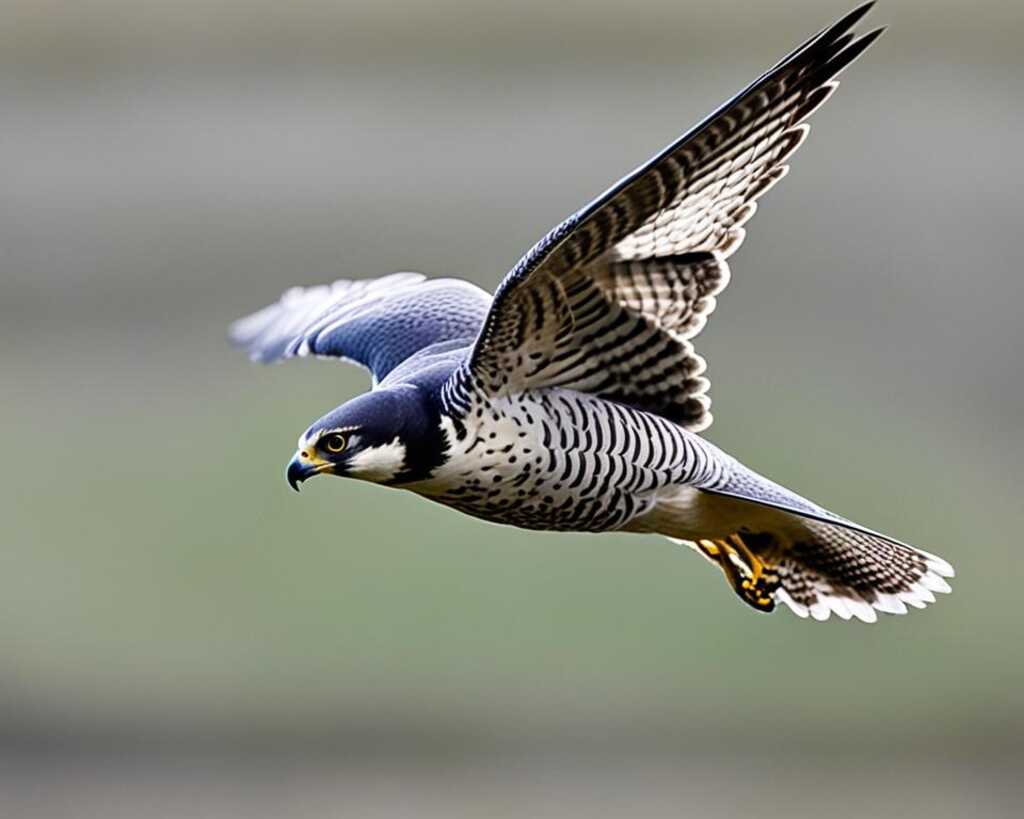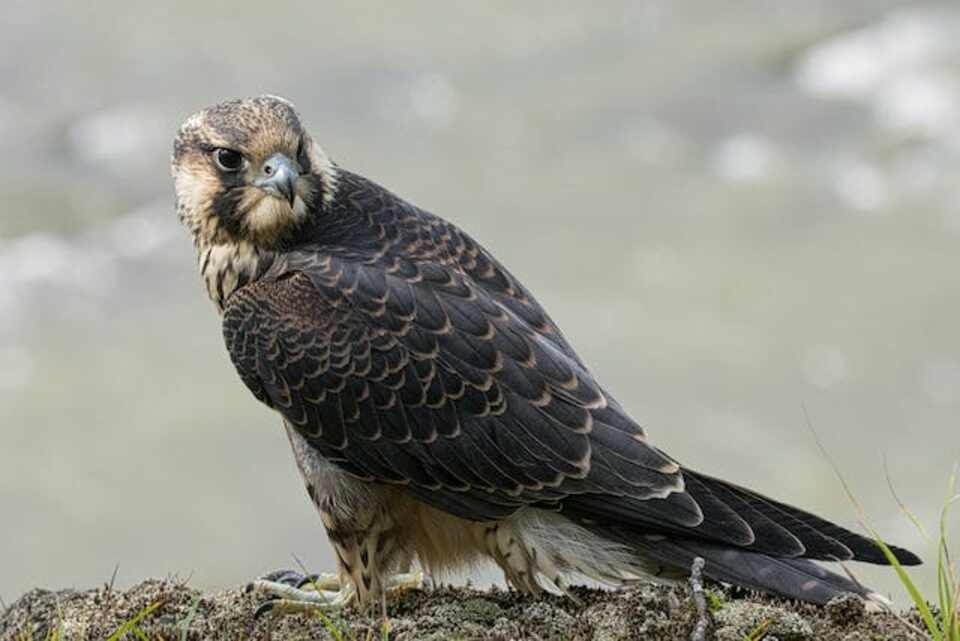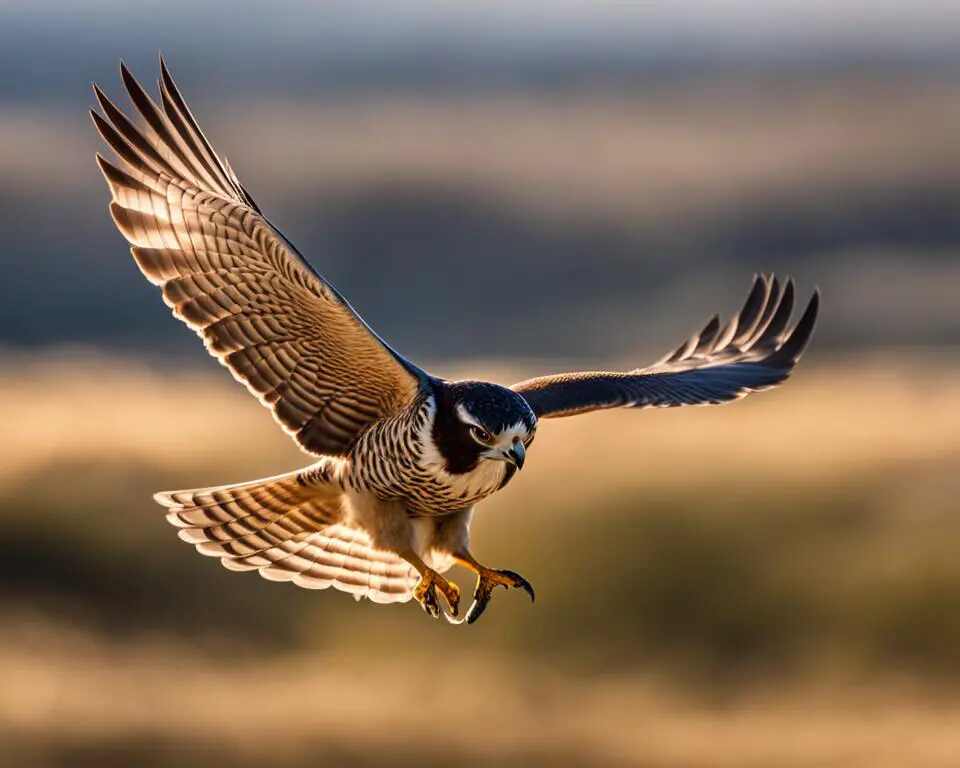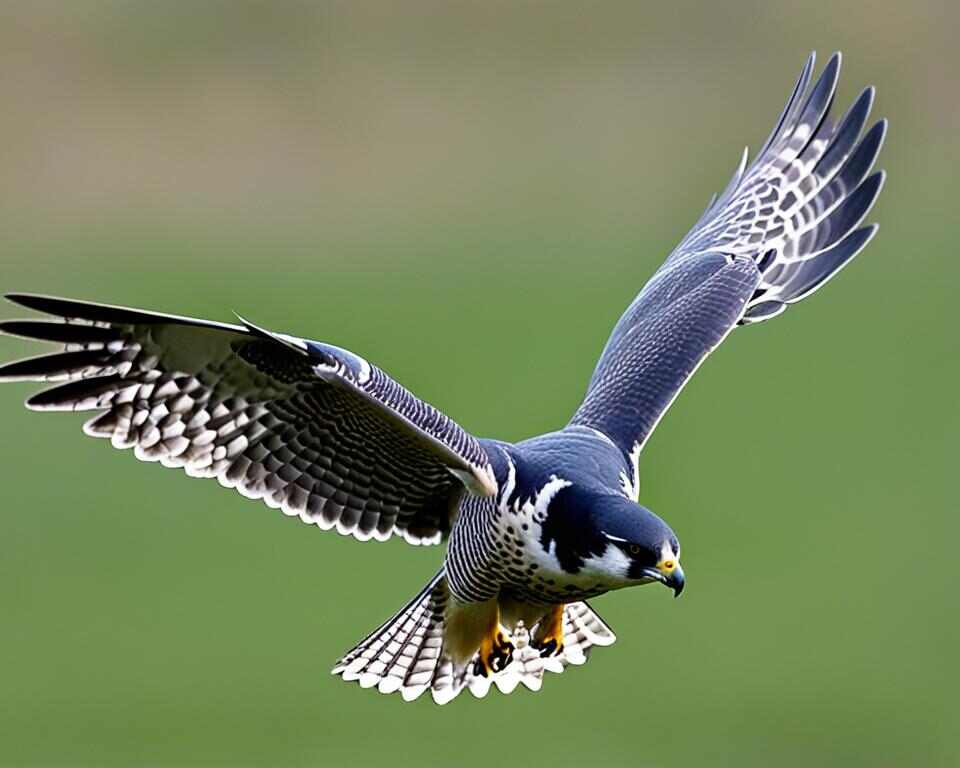Have you ever wondered, what’s the world’s fastest bird? It’s the peregrine falcon—a true speedster of the skies. This incredible raptor can reach speeds of over 240 miles per hour when diving for prey, making it not just fast, but the fastest animal on Earth. In this article, we’ll uncover what gives the peregrine falcon its high-speed edge and how it uses that power to thrive in the wild.
Table of Contents
- 1 Key Takeaways:
- 2 What is the fastest bird in the world?
- 3 How Peregrine Falcons Hunt Their Prey
- 4 How Falcons Achieve Their Incredible Speed
- 5 The Peregrine’s Prey: Their Hunting Strategy
- 6 Speedsters of the Sky: Not Just Peregrines
- 7 How Researchers Measure Bird Speed
- 8 Speed and Survival: Hunting Tactics in Birds
- 9 Bird Flight Speed Comparison
- 10 Conclusion
- 11 FAQs
- 11.1 How does the Peregrine falcon achieve its remarkable speed?
- 11.2 How does the Peregrine falcon’s diving speed compare to other birds?
- 11.3 What are the anatomical features that contribute to the Peregrine falcon’s speed?
- 11.4 How does the Peregrine falcon hunt its prey?
- 11.5 Are there any other birds besides the Peregrine falcon that are incredibly fast?
- 11.6 How do researchers measure the speed of birds?
- 11.7 What is the role of speed in bird survival and hunting tactics?
- 11.8 Are there any fascinating facts and world records related to bird speed?
- 11.9 How does the flight speed of different bird species compare?
- 12 Source Links
- 13 Author
Key Takeaways:
✅ The fastest bird on Earth holds multiple speed records
✅ Birds evolve unique traits to reach extreme speeds
✅ Speed is vital for hunting, survival, and mating
✅ Peregrine falcons are famous for their diving velocity
✅ Other birds also showcase incredible speed and agility
What is the fastest bird in the world?
Are you curious to know which bird holds the title for the fastest in the world? We will answer this question and provide a comprehensive understanding of the avian species that possess astonishing speed and agility.
| Bird | Top Speed |
|---|---|
| Peregrine Falcon | 240 miles per hour |
| Golden Eagle | 150 miles per hour |
| Grey-headed Albatross | 79 miles per hour |
| Sailfin Tern | 72 miles per hour |
| Spur-winged Goose | 70 miles per hour |
Among the record-breaking birds, the Peregrine Falcon reigns supreme with a top speed of 240 miles per hour, making it the undisputed fastest bird in the world.
However, other avian species also showcase remarkable speed and agility, including the Golden Eagle, Grey-headed Albatross, Sailfin Tern, and Spur-winged Goose.
These birds have adapted to achieve incredible velocity, allowing them to survive and thrive in their respective environments.
How Peregrine Falcons Hunt Their Prey
The Peregrine falcon, known as the fastest bird in the world, is a true marvel of nature. With its incredible speed and agility, this magnificent creature has captivated the imaginations of bird enthusiasts and scientists alike.
Let’s take a look at the secrets of the Peregrine falcon’s hunting technique, its impressive dive speed compared to other birds, and the remarkable adaptations that allow it to achieve high-speed flight.
Understanding the Peregrine Falcon’s Hunting Technique
The Peregrine falcon employs a hunting technique known as the “stoop.” This aerial attack involves a rapid descent from high altitudes, reaching speeds that are simply astonishing. With its keen eyesight, the Peregrine is able to spot its prey from great distances, lock onto it, and initiate a lightning-fast dive.
During the stoop, the Peregrine falcon tucks its wings close to its body, reducing air resistance and allowing it to achieve maximum velocity. This diving technique enables the Peregrine to strike its prey with incredible accuracy and force, making it one of nature’s most efficient predators.
Comparing the Peregrine’s Dive Speed to Other Birds
The Peregrine falcon’s dive speed is unmatched in the avian world. While the exact speed varies depending on various factors, studies have recorded Peregrines reaching speeds of over 240 miles per hour (386 kilometers per hour) during their stoop. This makes them the fastest flying creatures on Earth.
When compared to other birds, the Peregrine’s dive speed is truly exceptional. For example, the Golden Eagle, another formidable predator, typically reaches speeds of around 150 miles per hour (241 kilometers per hour) during its hunting dives. The Peregrine’s superior speed gives it a significant advantage when it comes to capturing prey in mid-air.
Adaptations for High-Speed Flight
The Peregrine falcon possesses a range of anatomical and physiological adaptations that contribute to its high-speed flight capabilities. Its streamlined body shape, with tapered wings and a long, pointed tail, minimizes drag and allows for efficient airflow, reducing turbulence and increasing speed.
In addition to its physical attributes, the Peregrine falcon’s respiratory system plays a crucial role in its ability to sustain high-speed flight. Its unique air sacs distribute oxygen more effectively, enabling the bird to maintain the required level of oxygenation during rapid descents and ascents.
| Bird Species | Dive Speed (mph) |
|---|---|
| Peregrine Falcon | 240+ |
| Golden Eagle | 150 |
The table above showcases the impressive dive speeds of the Peregrine falcon and the Golden Eagle, highlighting the Peregrine’s status as the fastest bird in the world. These avian speed records demonstrate the remarkable capabilities of these high-velocity creatures.
How Falcons Achieve Their Incredible Speed
Falcons, including the Peregrine falcon, are renowned for their exceptional speed. These rapid bird species have evolved unique anatomical features and utilize the principles of aerodynamics to achieve remarkable avian speed.
Anatomical Features Contributing to Speed
The Peregrine falcon possesses several anatomical adaptations that contribute to its falcon speed. Firstly, its streamlined body shape reduces drag, allowing for efficient flight. The long, pointed wings help generate lift and reduce turbulence, enabling swift maneuverability through the air.
Additionally, its muscular chest and strong wings provide the power necessary for rapid acceleration and sustained high-speed flight.
Furthermore, the Peregrine falcon’s sharp, curved beak and talons aid in hunting by allowing it to quickly strike and capture its prey. These specialized anatomical features demonstrate the bird’s evolutionary adaptations for speed and precision.
The Role of Aerodynamics in Peregrine Falcon’s Dive
The Peregrine falcon’s remarkable velocity is most evident during its dive, known as the stoop. During this hunting technique, the falcon will engage in a vertical dive, reaching astonishing speeds in its pursuit of prey.
A key factor in the falcon’s dive speed is its ability to streamline its body and position its wings and tail in ways that optimize efficiency and reduce drag. By folding its wings tightly against its body and tucking its tail, the Peregrine falcon minimizes resistance and creates a streamlined shape.
This aerodynamic positioning allows the bird to reach incredible velocities, often exceeding 240 miles per hour (386 kilometers per hour) during the stoop.
Through a combination of muscular power, anatomical adaptations, and aerodynamic principles, the Peregrine falcon has mastered the art of achieving remarkable velocity, solidifying its status as one of the fastest birds in the world.
| Common Name | Scientific Name | Flight Speed Range |
|---|---|---|
| Peregrine Falcon | Falco peregrinus | 240-250 mph (386-402 km/h) |
| Gyrfalcon | Falco rusticolus | 90-100 mph (145-161 km/h) |
| Spine-tailed Swift | Hirundapus caudacutus | 69-106 mph (111-170 km/h) |
The Peregrine’s Prey: Their Hunting Strategy
The Peregrine falcon’s hunting strategy is both fascinating and highly effective. These remarkable birds have evolved specialized hunting techniques to target and capture their prey, showcasing their exceptional adaptations and agility.
One of the key elements of the Peregrine falcon’s hunting strategy is its incredible speed. With speeds that can exceed 240 miles per hour (386 kilometers per hour) during its aerial dive, known as a stoop, the Peregrine falcon is the fastest animal on Earth. This exceptional velocity allows them to swiftly close the distance between themselves and their prey.
Once in close proximity to their prey, Peregrine falcons employ a combination of stealth, precision, and agility to ensure a successful capture. They often ambush their prey from above, using their sharp eyesight to spot potential targets from high perches or while in flight.
When the ideal moment presents itself, the Peregrine falcon initiates the stoop, diving at tremendous speed towards its prey. During this rapid descent, the falcon tucks its wings close to its body, reducing drag and allowing for increased velocity. This highly calculated approach enables the falcon to strike its prey with incredible force, delivering a swift and lethal blow.
Peregrine falcons primarily prey upon smaller birds, selecting targets that are within their size range. This includes pigeons, doves, and various songbirds. It is interesting to note that the Peregrine falcon’s choice of prey may vary depending on the region and availability of suitable prey species.
Overall, the Peregrine falcon’s hunting strategy is a spectacular display of speed, precision, and adaptability. Through their mastery of the skies and their remarkable hunting techniques, these birds have earned their place as the ultimate aerial predators.
Speedsters of the Sky: Not Just Peregrines
In addition to the Peregrine falcon, there are several other swift avian species that showcase incredible speed and agility. These fast birds exhibit rapid flying capabilities and are truly a sight to behold. Let’s take a closer look at some of the speediest flying creatures in the avian world.
The White-throated Needletail: Speed in Level Flight
One notable swift avian species is the White-throated Needletail. Known for its remarkable speed in level flight, this bird can reach impressive velocities. With elegant and streamlined wings, the White-throated Needletail effortlessly cuts through the air, showcasing its swift and agile nature. It’s a true marvel of avian engineering.
Other Fast Birds: From the Spine-tailed Swift to the Gyrfalcon
The White-throated Needletail (formerly known as the Spine-tailed Swift) is a bird that stands out among fast-flying species deserving of recognition. This avian marvel boasts remarkable speed and aerial prowess. With its elongated wings and slender body, the White-throated Needletail is perfectly adapted for rapid aerial maneuvers, showcasing the incredible agility of these fascinating birds.
Another notable mention is the Gyrfalcon, known for its impressive hunting speed. As one of the largest falcons, the Gyrfalcon combines power and agility, allowing it to soar through the skies at incredible velocities. Its ability to reach such high speeds is a testament to its exceptional flight capabilities.
These examples highlight the diversity of fast birds in the avian world. From the White-throated Needletail’s speed in level flight to the Spine-tailed Swift’s agility and the Gyrfalcon’s hunting prowess, these swift avian species are a testament to the wonders of nature.
How Researchers Measure Bird Speed
Have you ever wondered how researchers measure the speed of birds? Tracking avian velocity is not an easy task, but scientists have developed innovative technologies and methods to accomplish this feat.
The technology behind tracking bird speed involves a combination of modern tools and scientific expertise. One commonly used method is the use of radar, which allows researchers to monitor the movement of birds in real-time. Radar systems can detect and track the movement of birds by emitting radio waves that bounce off their bodies, providing valuable data on their speed and flight path.
Another method for measuring bird speed is the use of high-speed cameras. These cameras capture birds in flight, allowing researchers to analyze their wing movements and calculate their velocity. By tracking the distance traveled by the bird per unit of time, scientists can determine its speed accurately.
Verifying speed records of birds is an essential step in ensuring accuracy and reliability. Speed records are typically verified through careful observation and data analysis. Researchers may use multiple techniques, such as video analysis or visual tracking, to confirm the accuracy of recorded speeds.
Additionally, speed records may be cross-referenced with existing scientific literature and historical records to ensure consistency.
Speed and Survival: Hunting Tactics in Birds
Speed is a critical factor in the survival and hunting tactics of birds. Their ability to fly swiftly enables them to navigate their environment, escape predators, and efficiently capture prey. In this section, we will explore the predator and prey dynamics associated with bird speed, as well as the advantages of speed in terms of mating and migration.
Predator and Prey Dynamics in Bird Speed
The incredible speed of birds gives them a significant advantage when it comes to evading predators. By being able to take flight quickly and maintain high speeds, they can easily outmaneuver their pursuers. The ability to change direction rapidly and accelerate at a moment’s notice helps birds escape dangerous situations and ensure their survival.
On the other hand, birds with swift and agile flight capabilities also excel in hunting. They can chase down prey with impressive precision, using their speed to target and capture faster or elusive creatures. This hunting strategy allows them to secure their next meal, providing sustenance for their survival.
The Role of Speed in Mating and Migration
Speed plays a crucial role in the mating and migration behaviors of birds. During the mating season, male birds often engage in elaborate courtship displays to attract females. The ability to perform these intricate displays with speed and precision showcases the male’s physical fitness and genetic superiority, increasing their chances of successful reproduction.
When it comes to migration, speed allows birds to cover long distances efficiently. By flying at high speeds, birds can minimize the time spent on their journey, ensuring they reach their destination and find suitable habitats and food sources.
This advantage is especially crucial during seasonal migrations when birds need to navigate vast distances to optimize their survival and reproductive success.
Overall, speed plays a fundamental role in the survival, hunting tactics, mating, and migration strategies of birds. Their ability to fly swiftly grants them the advantage they need in the ever-competitive natural world.
Bird Flight Speed Comparison
When it comes to avian flight speed, the world of birds unveils an array of remarkable capabilities. In this section, we will delve into a fascinating comparison of the flight speeds of various bird species. Let’s embark on a journey to uncover just how fast these winged wonders can fly!
Title Holder of the Fastest Bird in Level Flight
The title holder of the fastest bird in level flight is the Peregrine falcon. Renowned for its extraordinary speed, this majestic bird can reach impressive velocities. However, it’s essential to explore other swift species that can give the Peregrine falcon a run for its money.
By examining these avian marvels, we can gain a comprehensive understanding of the true contenders for the fastest bird in level flight.
Diving Speed vs Level Flight: What’s the Difference?
When discussing bird flight speed, it’s crucial to distinguish between diving speed and level flight speed. Diving speed refers to the remarkable velocity birds can achieve during a rapid descent, often when targeting prey.
On the other hand, level flight speed pertains to the overall speed maintained by birds during regular flight without descending. Understanding the difference between these two types of speeds provides fascinating insights into the capabilities of avian species.
Conclusion
In conclusion, the world of avian speed is truly awe-inspiring. From the remarkable Peregrine falcon to other swift species, birds have evolved incredible adaptations and techniques to achieve astonishing velocity. The Peregrine falcon, with its unmatched hunting technique and anatomical features, holds the title for the fastest bird in the world.
Throughout this article, we have explored the role of speed in avian survival, hunting strategies, and mating and migration patterns. We have also introduced other rapid species like the White-throated Needletail, Spine-tailed Swift, and Gyrfalcon, each with their unique characteristics.
We hope this article has provided you with a deep understanding and appreciation for the amazing capabilities of these swift creatures. Whether in level flight or diving from great heights, birds prove to be master navigators of the sky.
The next time you spot a bird soaring through the air, take a moment to marvel at its speed and the adaptations that enable its incredible velocity.
FAQs
How does the Peregrine falcon achieve its remarkable speed?
The Peregrine falcon achieves its remarkable speed through its unique hunting technique and anatomical adaptations.
How does the Peregrine falcon’s diving speed compare to other birds?
The Peregrine falcon’s diving speed is unmatched and faster than any other bird.
What are the anatomical features that contribute to the Peregrine falcon’s speed?
The Peregrine falcon possesses specialized adaptations, such as streamlined body shape and powerful wings, that enable high-speed flight.
How does the Peregrine falcon hunt its prey?
The Peregrine falcon uses a hunting technique called stooping, where it dives at high speed to capture its prey.
Are there any other birds besides the Peregrine falcon that are incredibly fast?
Yes, there are other avian species with impressive speed, such as the White-throated Needletail, Spine-tailed Swift, and Gyrfalcon.
How do researchers measure the speed of birds?
Researchers use various technologies and methods, including radar tracking and GPS devices, to measure the velocity of birds.
What is the role of speed in bird survival and hunting tactics?
Speed plays a crucial role in bird survival, allowing them to evade predators and capture prey more efficiently.
Yes, there are fascinating world records and facts related to bird speed, including the fastest flying animal.
How does the flight speed of different bird species compare?
We will explore the flight speeds of various bird species and compare their level flight and diving speeds.





